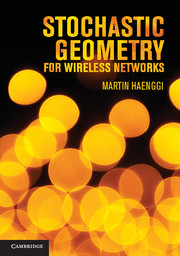Book contents
- Frontmatter
- Contents
- Preface
- Notation
- Part I Point process theory
- 1 Introduction
- 2 Description of point processes
- 3 Point process models
- 4 Sums and products over point processes
- 5 Interference and outage in wireless networks
- 6 Moment measures of point processes
- 7 Marked point processes
- 8 Conditioning and Palm theory
- Part II Percolation, connectivity, and coverage
- Appendix Introduction to R
- References
- Index
1 - Introduction
from Part I - Point process theory
Published online by Cambridge University Press: 05 November 2012
- Frontmatter
- Contents
- Preface
- Notation
- Part I Point process theory
- 1 Introduction
- 2 Description of point processes
- 3 Point process models
- 4 Sums and products over point processes
- 5 Interference and outage in wireless networks
- 6 Moment measures of point processes
- 7 Marked point processes
- 8 Conditioning and Palm theory
- Part II Percolation, connectivity, and coverage
- Appendix Introduction to R
- References
- Index
Summary
What is stochastic geometry?
Stochastic geometry (sometimes used synonymously with the older term geometric probability) deals with random spatial patterns. Random point patterns or point processes are the most basic and important such objects, hence point process theory is often considered to be the main sub-field of stochastic geometry. Stochastic geometry provides answers to questions such as the following.
How can one describe a (random) collection of points in one, two, or higher dimensions?
How can one derive statistical properties of such a collection of points?
How can one calculate statistical averages over all the possible realizations of such a random collection?
How can one condition on having a point at a fixed location?
Given an empirical set of points, which statistical model is likely to produce this point set?
How can one describe more general random geometric objects such as a “random line” or a “random triangle”?
Throughout this book, we will use point processes to model the distributions of nodes (users, wireless terminals) in a wireless network where node locations are subject to uncertainty. In Part II, we will also encounter random geometric graphs to address the connectivity of wireless networks and random regions in the context of coverage problems.
Point processes as spatial models for wireless networks
Loosely speaking, a point process is a random collection of points that reside in some space. In this book, we will focus on the one-, two-, and three-dimensional Euclidean spaces ℝ, ℝ2, and ℝ3, since, in our applications, the points represent the locations of wireless nodes in the real world.
Information
- Type
- Chapter
- Information
- Stochastic Geometry for Wireless Networks , pp. 3 - 8Publisher: Cambridge University PressPrint publication year: 2012
